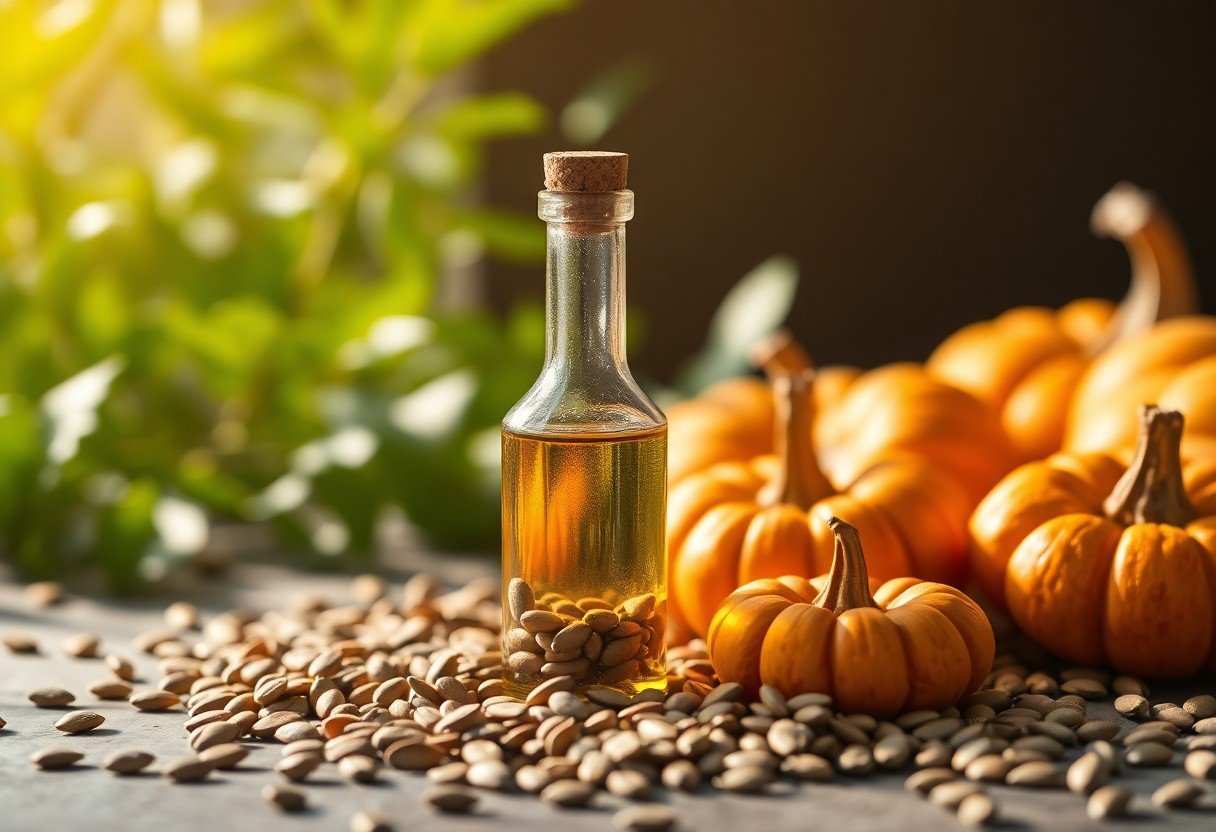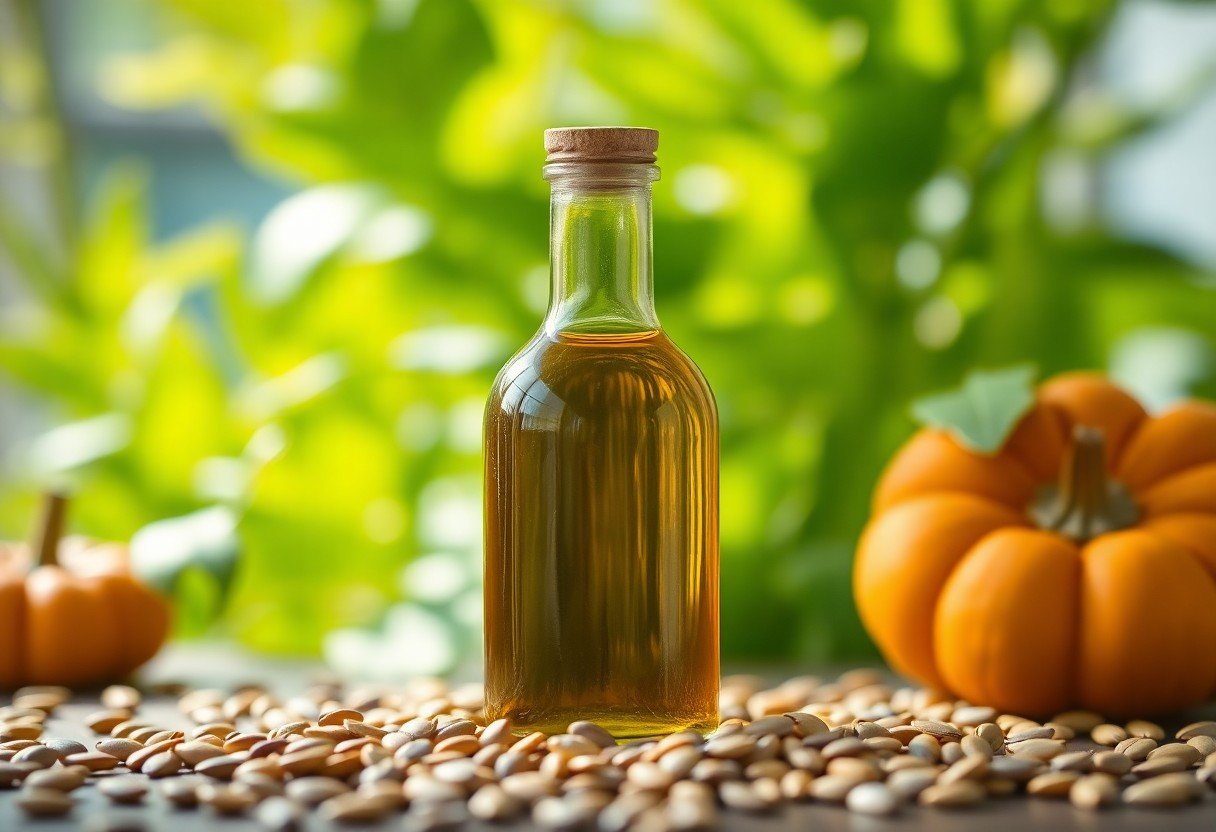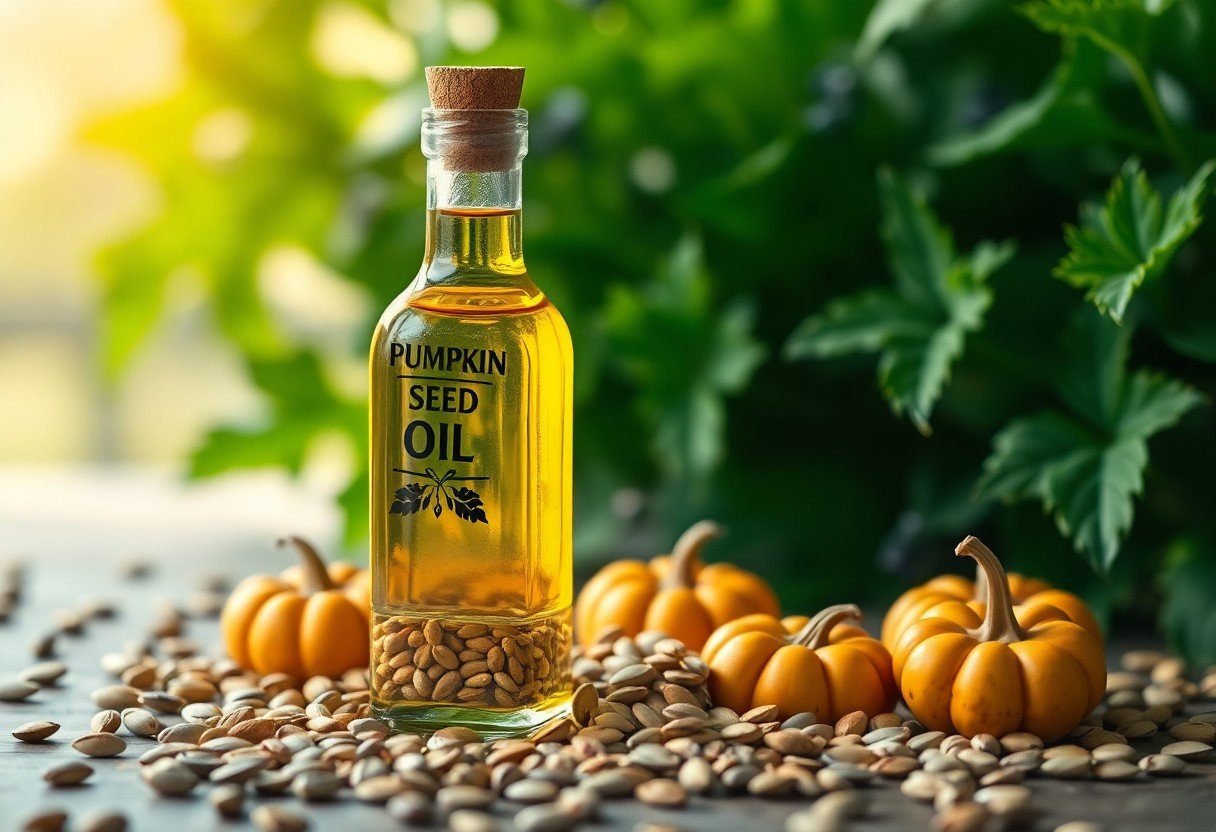Overlooked by many, pumpkin seed oil could be your natural solution for healthier, thicker hair growth. You might be surprised to learn that this nutrient-rich oil contains powerful DHT blockers and important compounds that can help prevent hair loss and stimulate new growth. Your scalp and hair follicles can benefit from its high concentrations of zinc, magnesium, and omega-3 fatty acids. Whether you’re dealing with thinning hair or simply want to enhance your hair’s natural vitality, pumpkin seed oil offers a safe, chemical-free alternative to conventional hair treatments.
Types of Pumpkin Seed Oil
The market offers various types of pumpkin seed oil to suit your hair care needs. From processing methods to quality standards, you’ll find options including cold-pressed, refined, organic, and conventional varieties. Recognizing the right type for your hair goals helps maximize the benefits.
| Type | Characteristics |
|---|---|
| Cold-Pressed | Raw, nutrient-rich, dark green color |
| Refined | Lighter color, processed, longer shelf life |
| Organic | Pesticide-free, environmentally friendly |
| Non-Organic | Conventional farming, more affordable |
| Virgin | First press, highest quality, unrefined |
Cold-Pressed vs. Refined
Types of processing significantly impact the oil’s effectiveness for hair care. Cold-pressed pumpkin seed oil retains more nutrients and natural compounds, making it ideal for hair growth and scalp health. You’ll find refined versions offer better stability but fewer active ingredients.
Organic vs. Non-Organic
You can choose between organic and conventional pumpkin seed oils for your hair care routine. Organic options ensure you’re avoiding potential chemical residues and supporting sustainable farming practices.
The difference between organic and non-organic extends beyond just certification. Organic pumpkin seed oil typically contains higher levels of beneficial compounds and poses zero risk of pesticide exposure. While conventional options are more accessible and budget-friendly, they might contain trace amounts of agricultural chemicals.

Benefits of Pumpkin Seed Oil for Hair
While exploring natural hair care solutions, pumpkin seed oil emerges as a powerful ally for your hair health. This nutrient-rich oil contains crucial compounds that can help prevent hair loss, stimulate growth, and improve overall scalp condition. Its unique combination of vitamins, minerals, and fatty acids works together to nourish your hair follicles and promote healthier, stronger strands.
Nutritional Profile
You’ll find an impressive array of nutrients in pumpkin seed oil that benefit your hair health. The oil is rich in zinc, iron, and crucial fatty acids, particularly omega-3 and omega-6. Your hair receives nourishment from vitamins A, K, and E, along with minerals that support scalp health and hair growth.
Impact on Hair Growth
Profile studies show that pumpkin seed oil can block DHT, a hormone linked to hair loss. Your regular use of this oil may help maintain existing hair and encourage new growth, particularly in areas experiencing thinning. Research indicates that you can expect visible results within 3-6 months of consistent application.
To maximize the benefits for your hair growth, you can apply pumpkin seed oil directly to your scalp or include it in your diet. Regular scalp massages with the oil can improve blood circulation and enhance nutrient delivery to your hair follicles. Your best results will come from combining topical application with dietary intake, as this dual approach supports hair health from both inside and out.
Tips for Using Pumpkin Seed Oil
Assuming you’re ready to incorporate pumpkin seed oil into your hair care routine, proper application and timing are vital for optimal results. Start with a patch test on a small area to ensure no adverse reactions. When applying, ensure your hair is clean and slightly damp for better absorption. Knowing the right amount is key – start with 3-4 drops for short hair and 6-8 drops for longer hair.
Application Methods
With pumpkin seed oil, you have several effective application options. You can massage it directly into your scalp, mix it with your regular conditioner, or create a pre-shampoo treatment. For deeper penetration, warm the oil slightly between your palms before application. Apply it section by section, focusing on your scalp and working your way to the ends.
Frequency of Use
To achieve the best results, apply pumpkin seed oil 2-3 times per week. If you have an oily scalp, limit usage to once weekly, while those with dry hair can apply it more frequently. Avoid daily application as it may lead to product buildup.
Frequency of application depends on your hair type and concerns. For hair growth, consistent bi-weekly treatments are recommended. If you’re treating dry scalp, weekly applications work best. Excessive use can make your hair appear greasy, so monitor your hair’s response and adjust accordingly. You can increase or decrease frequency based on how your hair reacts to the treatment.

Step-by-Step Guide to Applying Pumpkin Seed Oil
Now, let’s explore the systematic approach to using pumpkin seed oil for your hair care routine. This method ensures maximum absorption and optimal results for your hair health.
| • Pumpkin seed oil • Shower cap • Towel |
• Wide-toothed comb • Spray bottle • Timer |
Preparation
Even beginners can master this simple preparation process. Warm the oil slightly by placing the bottle in warm water for 2-3 minutes. This enhances absorption into your hair follicles. Section your clean, damp hair into manageable parts for easier application.
Application Technique
Even distribution is key to achieving the best results. Start by applying the oil to your scalp using gentle, circular motions with your fingertips. Work your way from the roots to the tips, ensuring each section is thoroughly covered.
Guide the oil through your hair using a wide-toothed comb to ensure even distribution. Massage your scalp for 5-10 minutes to stimulate blood flow and enhance absorption. Cover your hair with a shower cap and let the oil work its magic for 30 minutes to 2 hours.
Rinsing Instructions
Applying the right rinsing technique ensures you’ll remove all oil residue while maintaining the benefits. Use warm water and a mild shampoo, washing twice if necessary to achieve a clean, non-greasy result.
Instructions for thorough rinsing include using lukewarm water for the first wash, followed by cooler water for the final rinse. This helps seal your hair cuticles and lock in the nourishing benefits of the pumpkin seed oil. Avoid hot water as it can strip away the beneficial oils.
Factors to Consider
For optimal results with pumpkin seed oil hair treatment, several key factors need your attention. Understanding your hair type, existing scalp conditions, and potential sensitivities will help you maximize benefits. The quality and purity of the oil, proper application methods, and consistency in usage play vital roles in achieving desired results. Perceiving these elements ensures you make informed decisions about incorporating pumpkin seed oil into your hair care routine.
Hair Type Compatibility
To determine if pumpkin seed oil suits your hair, consider your hair’s natural characteristics. Fine hair may require lighter applications to avoid weighing it down, while thick or coarse hair can handle more generous amounts. You’ll find this oil particularly beneficial for dry and damaged hair types, as it provides deep moisturizing without excessive greasiness.
Allergies and Sensitivities
You should always perform a patch test before applying pumpkin seed oil to your scalp or hair. Apply a small amount to your inner arm and wait 24 hours to check for any adverse reactions. Skin irritation, redness, or itching are signs that you might be sensitive to the oil.
Consider the following precautions before using pumpkin seed oil:
- Pure oil selection – choose unrefined, organic options
- Potential interactions with other hair products
- Immediate discontinuation if you experience any discomfort
- Consulting with a healthcare provider if you have existing scalp conditions

Pros and Cons of Pumpkin Seed Oil for Hair
All natural hair care solutions come with their benefits and drawbacks, and pumpkin seed oil is no exception. While this nutrient-rich oil offers numerous advantages for your hair health, it’s necessary to understand both its positive and negative aspects before incorporating it into your hair care routine.
Advantages
There’s significant evidence supporting pumpkin seed oil’s benefits for your hair health. The oil’s high concentration of antioxidants and necessary nutrients helps strengthen your hair from root to tip. Its natural DHT-blocking properties make it particularly effective for preventing hair loss, while its anti-inflammatory properties soothe your scalp and promote healthy hair growth.
Disadvantages
Hair care with pumpkin seed oil isn’t without its drawbacks. The oil’s heavy consistency can make your hair appear greasy if not properly applied, and some users may experience allergic reactions or scalp sensitivity. You might also find the distinctive nutty aroma overwhelming.
A major consideration when using pumpkin seed oil is its potential to stain fabrics and its relatively short shelf life. You’ll need to be careful with application and storage, and should perform a patch test before full application to avoid any adverse reactions. The oil’s effectiveness can also vary significantly depending on your hair type and existing hair conditions.
Summing up
From above, you can see that pumpkin seed oil offers multiple benefits for your hair health. Whether you’re dealing with hair loss, thinning strands, or seeking overall hair wellness, this nutrient-rich oil can be a valuable addition to your hair care routine. Its high content of zinc, fatty acids, and DHT-blocking properties makes it an effective natural solution for promoting hair growth and maintaining scalp health. By incorporating pumpkin seed oil into your regular hair care regimen, you can work towards achieving stronger, healthier, and more vibrant hair.
FAQ
Q: How does pumpkin seed oil benefit hair growth?
A: Pumpkin seed oil contains high levels of phytosterols and fatty acids that block DHT (dihydrotestosterone), a hormone linked to hair loss. It’s rich in zinc, magnesium, and omega-3 fatty acids, which promote follicle health and stimulate new hair growth. Studies show that regular use can increase hair count by up to 40% in men with pattern baldness.
Q: What’s the best way to apply pumpkin seed oil to hair?
A: Warm 2-3 tablespoons of pumpkin seed oil between your palms and massage it directly into your scalp for 5-10 minutes. Leave it on for at least 30 minutes or overnight for maximum absorption. Apply twice weekly for optimal results. You can also mix it with other carrier oils like coconut or jojoba oil for enhanced benefits.
Q: Can pumpkin seed oil help with dry, damaged hair?
A: Yes, pumpkin seed oil is excellent for dry and damaged hair due to its high vitamin E content and crucial fatty acids. These nutrients help seal moisture into the hair shaft, reduce frizz, and repair split ends. Regular use can improve hair elasticity, shine, and overall manageability while protecting against environmental damage.
Q: Are there any side effects of using pumpkin seed oil on hair?
A: Pumpkin seed oil is generally safe for all hair types, but some people may experience mild scalp irritation or allergic reactions. Always perform a patch test before full application. If you have extremely oily hair, use it sparingly as it may weigh down your hair. Discontinue use if you experience any adverse reactions like itching or redness.
Q: How long does it take to see results from pumpkin seed oil treatment?
A: Most people start noticing improvements in hair texture and shine within 2-3 weeks of regular use. For hair growth benefits, expect to see results after 2-3 months of consistent application. Individual results may vary depending on hair type, condition, and frequency of use. Maintaining a healthy diet and proper hair care routine will enhance the oil’s effectiveness.

